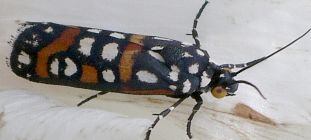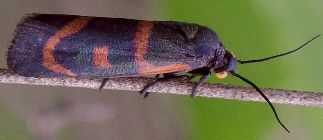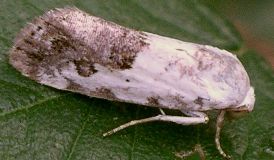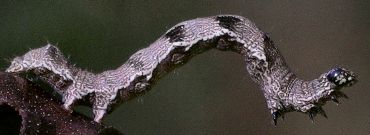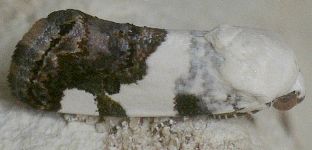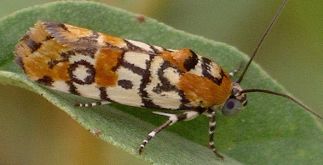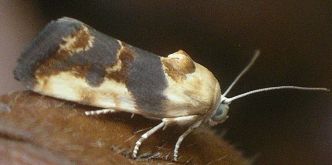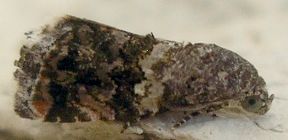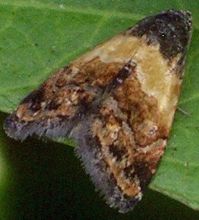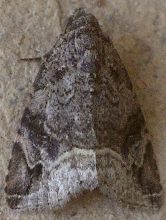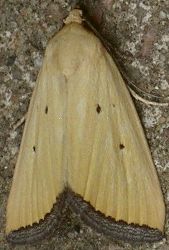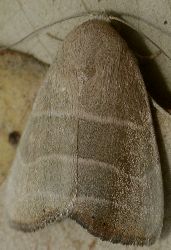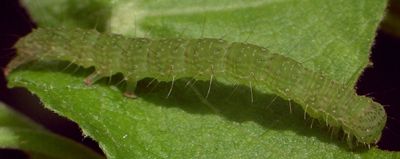
| Noctuidae ~ Owlet Moths |
page 1 ![]() page 2
page 2 ![]() page 3
page 3 ![]() page 4
page 4 ![]() page 5
page 5 ![]() page 6
page 6 ![]() page 7
page 7 ![]() page 8
page 8
|
Not all noctuids are medium to large sized. Some are so small that they often overlooked and may be hard to place in this family at all. One of the most lovely of these is the Straight-lined Cydosia (Cydosia aurivitta). It is common in the spring, especially in fields with tall grass that has not been mowed. The really neat thing about this moth is that there are two distinct color forms in our area. While they look completely unrelated at first glance, note that the darker version is simply missing the white markings. Otherwise, they are the same. This species shows a characteristic common to many members of this group: weird large eyes that have a well-defined "pupil" which looks very un-moth-like. The head is held low, giving the insect a hunch-backed appearance, and the eyes are often a complimentary color that matches very nicely with the wing markings. In the case of C. aurivitta, the eyes are orange.
Several genera in this group have adults that mimic bird droppings. This is not the only group, or even family, to use this disguise, but it is one of the best. There has recently been a shuffling and renaming of species within these genera. In general, those that used to be in the genera Fruva and Tarachidia are now in Ponometia. Most of the species in Acontia have been moved to Tarache. Got all that? If you do, you are ahead of me; I find it quite confusing. It requires close observation to distinguish between our various "bird dropping" moths. Their differences are slight and so are they. Acontia cretata and the Olive-shaded Bird Dropping Moth (Ponometia candefacta) are one look-alike pair. Both are about 10 mm long and tend to be found in the spring and fall. P. candefacta is usually more common. It also has more distinct markings, including tiny black dots, both in the middle of the wing and along the edge. There is a gray blob surrounded by white in the edge of the brownish marking on the wing. All these features are missing on A. cretata, which overall looks like its markings are a bit more blurred.
The Small Bird Dropping Moth (Ponometia erastrioides) and P. phecolisca are another pair that are similar. They are both only about 8 mm long and their markings are more distinct than the previous two species. Both have the tiny black dot almost halfway down the forewing. They also both have the part brown and part white look that makes them so amazingly resemble bird droppings. Separate them by these clues: P. phecolisca has more extensive brown, including the rear edge of the forewing, while P. erastrioides lacks the black-rimmed brown blob at the edge of the dark colors in the lower center of the wing.
By the way, these moths tend to sit out in the open, often right on leaves or stones, and rarely move, even when prodded. They have definitely evolved to mimic bird droppings, and those don't fly away!
Not all the Ponometia species mimic bird droppings. P. fasciatella, which used to be in the genus Fruva, is a vaguely mottled brown. It is rather common, especially in the spring and fall. The Half-yellow (Ponometia semiflava) sure took a lot of imagination to name. It is a delightfully marked moth that also appears spring and fall. Both of these are on the small side, about 8-9 mm long, and I usually see them out in weedy fields. As with the other Ponometia species, they have greenish eyes.
The larvae of this genus resemble inchworms, which are in the family Geometridae. However, at the rear end, they have THREE pairs of legs instead of the two found on geometrids. They are slender, have mottled heads, a raised lateral ridge and a rear bump. The best place to find them is on Ragweed. Yet another pair of similar species are found in this group. The Exposed Bird Dropping Moth (Tarache aprica) and the Four-spotted Bird Dropping Moth (Tarache tetragona) are both very common, especially in the spring and fall, although I do find them occasionally during the summer too. While Ponometia species have green eyes, these have rusty brown. Boy, there's an obscure detail that won't help with pinned specimens. Length of both species is about 12 mm. Males and females are very different. This can cause confusion, so beware of this characteristic. In general, females have more extensive dark markings. The most reliable feature to look for is a black dot in the middle of the forewing on T. aprica (I always remember this by thinking of "prick" like in pin). It can be very noticeable or just a teensy point. T. tetragona does not have the tiny black dot.
One other genus that is similar to the above, at least in shape, is Spragueia. Nothing need be said about the markings. Aren't they fabulous? I have seen more Spragueia guttata than S. obatra, but both have lovely blue eyes. They appear to be late summer or early autumn moths, and are rather small, at about 8 mm in length.
The genus Tripudia contains some very small moths, none of which seem to have drawn enough attention to have common names. T. quadrifera is by far the most common and I've seen this species from March through Oct. At about 7 mm in length, T. quadrifera and T. luxuriosa are the big ones - T. flavofasciata is only about 6 mm long! I usually find these little sprites resting on vegetation rather than at lights. They will fly readily if disturbed.
The Aerial Brown (Ozarba aeria) is a species that I've only seen once. It was attracted to lights in late May. Size is about 8 mm long. I think it is easily confused with the midgets (genus Elaphria), but those are a little larger. Another single sighting added Diastema tigris. This 11 mm long moth is so distinctive that an ID is simple. There is just nothing else that looks like it. The texture of the Straight-lined Seed Moth (Eublemma recta) could not be more different from D. tigris. While the latter is very rough looking, E. recta is sleek and elegant. This little insect is about 8 mm long and shows up in the fall, during which time it is moderately common. Its reddish-brown colors stand out against the green vegetation that I seem to find it on.
A common and easily identified small moth (10 mm long), the Black-bordered Lemon Moth is most often seen in April, usually attracted to lights. One of the most common caterpillars I find is that of the Straight-lined Mallow Moth (Bagisara rectifascia). I have never found an adult in the field, and only have a photo because I raised one of the caterpillars. The moth is about 12 mm long while the caterpillars reach about 30 mm. They are easily found throughout much of the summer feeding on Turk's Cap (Malvaviscus arboreus) and Rose Mallow (Pavonia lasiopetala). Although they resemble inchworms, they have three pairs of rear prolegs instead of just two. They sit right on top of the leaves, but their green color blends in. If disturbed, they will sometimes suddenly leap off and disappear into the leaf litter. Another Bagisara sp. feeds on Velvetleaf Mallow (Wissadula holosericea), but it is not very common. The color of the caterpillar matches the bluish tint of the leaves!
I've also seen a very similar caterpillar which I don't know at all; I've not raised this one to see what it turns into. This larva has a white lateral line and one additional pair of rear prolegs. |
page 1 ![]() page 2
page 2 ![]() page 3
page 3 ![]() page 4
page 4 ![]() page 5
page 5 ![]() page 6
page 6 ![]() page 7
page 7 ![]() page 8
page 8
![]()
